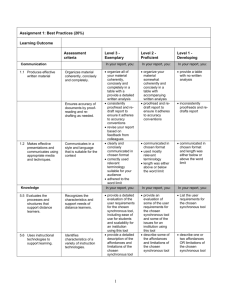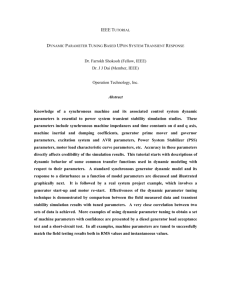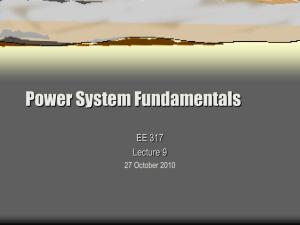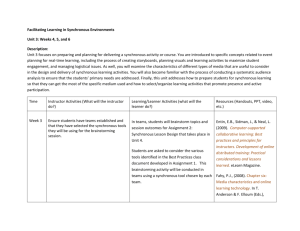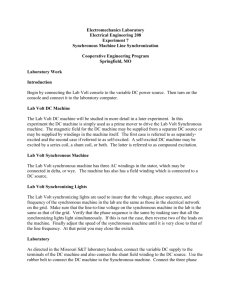Electrical Machines: II. Synchronous Generators
advertisement
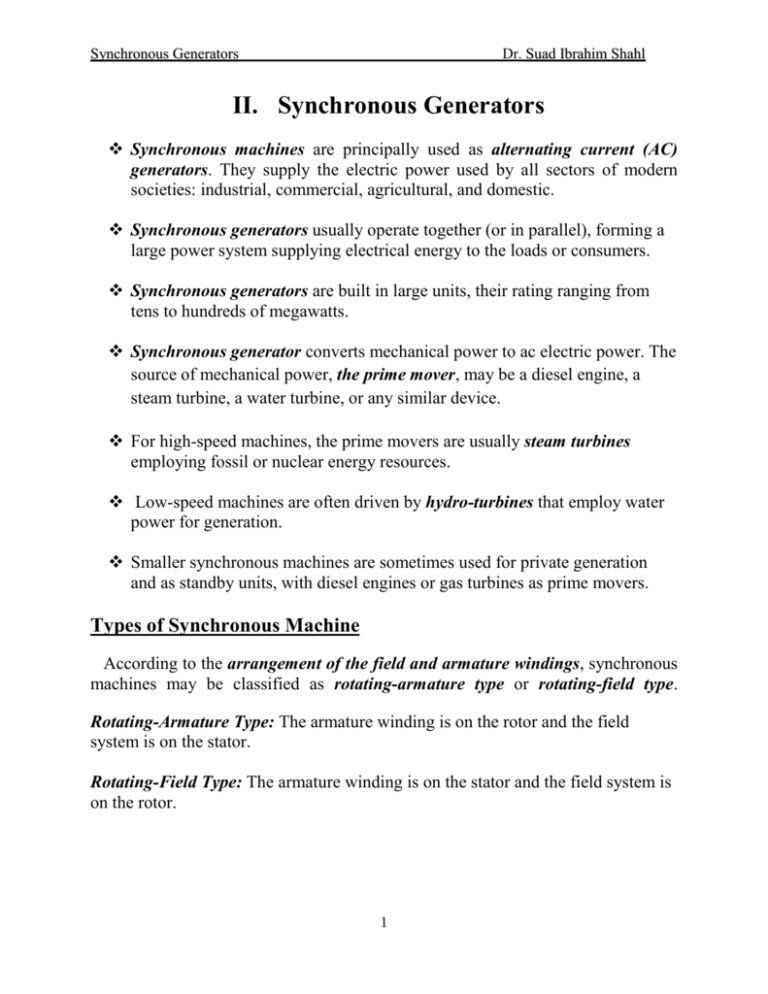
Synchronous Generators Dr. Suad Ibrahim Shahl II. Synchronous Generators Synchronous machines are principally used as alternating current (AC) generators. They supply the electric power used by all sectors of modern societies: industrial, commercial, agricultural, and domestic. Synchronous generators usually operate together (or in parallel), forming a large power system supplying electrical energy to the loads or consumers. Synchronous generators are built in large units, their rating ranging from tens to hundreds of megawatts. Synchronous generator converts mechanical power to ac electric power. The source of mechanical power, the prime mover, may be a diesel engine, a steam turbine, a water turbine, or any similar device. For high-speed machines, the prime movers are usually steam turbines employing fossil or nuclear energy resources. Low-speed machines are often driven by hydro-turbines that employ water power for generation. Smaller synchronous machines are sometimes used for private generation and as standby units, with diesel engines or gas turbines as prime movers. Types of Synchronous Machine According to the arrangement of the field and armature windings, synchronous machines may be classified as rotating-armature type or rotating-field type. Rotating-Armature Type: The armature winding is on the rotor and the field system is on the stator. Rotating-Field Type: The armature winding is on the stator and the field system is on the rotor. 1 Synchronous Generators Dr. Suad Ibrahim Shahl According to the shape of the field, synchronous machines may be classified as cylindrical-rotor (non-salient pole) machines and salient-pole machines 2 Synchronous Generators Dr. Suad Ibrahim Shahl Construction • • • The winding consists of copper bars insulated with mica and epoxy resin. The conductors are secured by steel wedges. The iron core is supported by a steel housing. 3 Synchronous Generators Dr. Suad Ibrahim Shahl Round rotor 4 Synchronous Generators • • Dr. Suad Ibrahim Shahl Low speed, large hydro-generators may have more than one hundred poles. These generators are frequently mounted vertically Salient Rotor Field Excitation and Exciters • • • DC field excitation is an important part of the overall design of a synchronous generator The field excitation must ensure not only a stable AC terminal voltage, but must also respond to sudden load changes Rapid field excitation response is important Three methods of excitation 1. 2. • • slip rings link the rotor’s field winding to an external dc source dc generator exciter a dc generator is built on the same shaft as the ac generator’s rotor a commutator rectifies the current that is sent to the field winding 5 Synchronous Generators Dr. Suad Ibrahim Shahl 3. brushless exciter • an ac generator with fixed field winding and a rotor with a three phase circuit • diode/SCR rectification supplies dc current to the field windings Typical brushless exciter system Ventilation or Cooling of an Alternator • The slow speed salient pole alternators are ventilated by the fan action of the salient poles which provide circulating air. • Cylindrical rotor alternators are usually long, and the problem of air flow requires very special attention. • The cooling medium, air or hydrogen is cooled by passing over pipes through which cooling water is circulated and ventilation of the alternator. • Hydrogen is normally used as cooling medium in all the turbine-driven alternators because hydrogen provides better cooling than air and increases the efficiency and decreases the windage losses. • Liquid cooling is used for the stators of cylindrical rotor generators. 6 Synchronous Generators Dr. Suad Ibrahim Shahl 7 Synchronous Generators • Dr. Suad Ibrahim Shahl The rms. value of the induced voltages are: Ean = Erms e i O deg • where: Erms = Ebn = Erms e − i120 deg kw ω N a Φ f 2 = 4.44 f N a Φ f k w k w = 0.85-0.95 is the winding factor. 8 Ecn = Erms e − i 240 deg Synchronous Generators Dr. Suad Ibrahim Shahl Φ 9 Synchronous Generators Dr. Suad Ibrahim Shahl H.W A four pole, three-phase synchronous generator is rated 250 MVA, its terminal voltage is 24 kV, the synchronous reactance is: 125%. • Calculate the synchronous reactance in ohm. • Calculate the rated current and the line to ground terminal voltage. • Draw the equivalent circuit. • Calculate the induced voltage, E f , at rated load and pf = 0.8 lag. (Ans: X syn =2.88Ω, Ig =6.01∟-36.87oKA, E gn =27.93∟29.74KV) 10 Synchronous Generators Dr. Suad Ibrahim Shahl Armature Reaction in Synchronous Machines Armature reaction refers to • the influence on the magnetic field in the air gap when the phase windings a, b, and c on the stator are connected across a load. • The flux produced by the armature winding reacts with the flux set up by the poles on the rotor, causing the total flux to change. The generator delivers a load at a unity power factor. Figure.1 (a) The per-phase equivalent circuit of a synchronous generator without armature reaction while depicting the revolving field produced by the rotor. The phasor diagrams for a (b) lagging pf, (c) unity pf, and (d) leading pf. 11 Synchronous Generators Dr. Suad Ibrahim Shahl (a) If Φ p is the flux per pole in the generator under no load, then the generated voltage E a must lag Φ p by 90o, as shown in Figure 2. ~ (b) Since the power factor is unity, the phase current I a is in phase with the ~ terminal phase voltage Va . ~ (c) As the phase current I a passes through the armature winding, its magnetomotive force (mmf) produces a flux Φ ar which is in phase with ~ I a . The effective flux Φ e per pole in the generator is the algebraic sum of the two fluxes; that is, Φ e = Φ p + Φ ar , as shown in the figure. Figure 2: Phasor diagram depicting the effect of armature reaction when the power factor is unity. ~ ~ (d) The flux Φ ar , in turn, induces an emf E ar in the armature winding. E ar is ~ called the armature reaction emf. The armature reaction emf E ar lags ~ the flux Φ ar by 90o. Hence the effective generated voltage per-phase E e ~ is the algebraic sum of the no-load voltage E a and the armature reaction ~ ~ ~ ~ emf E ar . That is, E e = E a + E ar . An equivalent circuit showing the armature reaction emf is given in Figure 3. 12 Synchronous Generators Dr. Suad Ibrahim Shahl Figure 3: A per-phase equivalent circuit showing the induced emf in the armature winding due to the armature reaction. ~ (e) The per-phase terminal voltage Va is obtained by subtracting the voltage drops ~ ~ ~ I a Ra and jI a X a from Ee . In other words, ~ ~ ~ Ee = Va + I a ( Ra + j X a ) From the phasor diagram, it should be obvious that the armature reaction has reduced the effective flux per pole when the power factor of the load is unity. Also, the terminal voltage is smaller than the generated voltage. Figure 4: The phasor diagram showing the effect of armature reaction when the power factor is lagging. 13 Synchronous Generators Dr. Suad Ibrahim Shahl By following the above sequence of events, we can obtain the phasor diagrams for the lagging (Figure 4) and the leading (Figure 5) power factors. From these figures it is evident that the resultant flux is (smaller/larger) with armature reaction for the ~ (lagging/leading) power factor than without it. In addition, the terminal voltage Va ~ is (higher/lower) than the generated voltage E a when the power factor is (leading/ lagging). Since the flux per pole Φ p is different for each of the three load conditions, the field current I f must be adjusted each time the load is changed. ~ ~ Since the armature reaction emf E ar lags the current I a by 90o, we can also express it as ~ ~ Ear = − jI a X m where X m , a constant of proportionality, is known as the magnetization reactance. Figure 5: The phasor diagram showing the effect of armature reaction when the power factor of the load is leading. Both the magnetization reactance and the leakage reactance are present at the same time. It is rather difficult to separate one reactance from the other. For this reason, the two reactances are combined together and the sum Xs = Xm + Xa is called the synchronous reactance. The synchronous reactance is usually very large compared with the resistance of the armature winding. We can now define the synchronous impedance on a per-phase basis as Z s = Ra + j X s 14 Synchronous Generators Dr. Suad Ibrahim Shahl Synchronous Generator Tests To obtain the parameters of a synchronous generator, we perform three simple tests as described below. The Resistance Test This test is conducted to measure-winding resistance of a synchronous generator when it is at rest and the field winding is open. The resistance is measured between two lines at a time and the average of the three resistance readings is taken to be the measured value of the resistance, R L , from line to line. If the generator is Yconnected, the per-phase resistance is Ra = 0.5 RL The Open-Circuit Test The open-circuit test, or the no-load test, is performed by 1) 2) 3) 4) Generator is rotated at the rated speed. No load is connected at the terminals. Field current is increased from 0 to maximum. Record values of the terminal voltage and field current value. Circuit diagram to perform open-circuit test. With the terminals open, I A =0, so E A = V φ. It is thus possible to construct a plot of E A or V T vs I F graph. This plot is called open-circuit characteristic (OCC) of a generator. With this characteristic, it is possible to find the internal generated voltage of the generator for any given field current. 15 Synchronous Generators Dr. Suad Ibrahim Shahl Open-circuit characteristic (OCC) of a generator The OCC follows a straight-line relation as long as the magnetic circuit of the synchronous generator does not saturate. Since, in the linear region, most of the applied mmf is consumed by the air-gap, the straight line is appropriately called the air-gap line. The Short-Circuit Test The short-circuit test provides information about the current capabilities of a synchronous generator. It is performed by 1) 2) 3) 4) Generator is rotated at rated speed. Adjust field current to 0. Short circuit the terminals. Measure armature current or line current as the field current is increased. 16 Synchronous Generators Dr. Suad Ibrahim Shahl SCC is essentially a straight line. To understand why this characteristic is a straight line, look at the equivalent circuit below when the terminals are short circuited. Circuit diagram to perform short-circuit test. When the terminals are short circuited, the armature current I A is: IA = And its magnitude is: I A= EA RA + jX S EA RA2 + X S2 From both tests, here we can find the internal machine impedance (E A from OCC, I A from SCC): ZS = RA2 + X S2 = EA IA Since X s >> R A , the equation reduces to: Xs ≈ E A Vφ oc = IA IA 17 Synchronous Generators Dr. Suad Ibrahim Shahl Short Circuit Ratio Ratio of the field current required for the rated voltage at open circuit to the field current required for rated armature current at short circuit. 𝐼𝐼𝑓𝑓,𝑂𝑂𝑂𝑂 𝑆𝑆𝑆𝑆𝑆𝑆 = 𝐼𝐼𝑓𝑓,𝑆𝑆𝑆𝑆 𝑆𝑆𝑆𝑆, 𝑆𝑆𝑆𝑆𝑆𝑆 = 18 1 𝑋𝑋𝑠𝑠 Synchronous Generators Dr. Suad Ibrahim Shahl Example: The following data are taken from the open- and short-circuit characteristics of a 45-kVA, three-phase, Y-connected, 220-V (line-to-line), six-pole, 60-Hz synchronous machine. From the open-circuit characteristic: Line-to-line voltage = 220 V Field current = 2.84 A From the short-circuit characteristic: From the air-gap line: Field current = 2.20 A Line-to-line voltage = 202 V 19 Synchronous Generators Dr. Suad Ibrahim Shahl Compute the unsaturated value of the synchronous reactance, its saturated value at rated voltage, and the short-circuit ratio. Express the synchronous reactance in ohms per phase and in per unit on the machine rating as a base. Solution At a field current of 2.20 A the line-to-neutral voltage on the air-gap line is and for the same field current the armature current on short circuit is Note that rated armature current is Therefore, la, sc = 1.00 per unit. The corresponding air-gap-line voltage is in per unit The saturated synchronous reactance can be found from the open- and short-circuit characteristics In per unit 20 Synchronous Generators Dr. Suad Ibrahim Shahl Finally, from the open- and short-circuit characteristics, the short-circuit ratio is given by The inverse of the short-circuit ratio is equal to the per-unit saturated synchronous reactance H.W Calculate the saturated synchronous reactance (in Ω/phase and per unit) of a 85 kVA synchronous machine which achieves its rated open-circuit voltage of 460 V at a field current 8.7 A and which achieves rated short-circuit current at a field current of 11.2 A. [Answer: Xs = 3.21 Ω/phase = 1.29 per unit] 21 Synchronous Generators Dr. Suad Ibrahim Shahl Voltage regulation of Alternator The voltage regulation of an Alternator is defined as the change in terminal voltage from no-load to load condition expressed as per-unit or percentage of terminal voltage at load condition; the speed and excitation conditions remaining same. Per unit Determination of Voltage Regulation The following are the three methods which are used to determine the voltage regulation of smooth cylindrical type Alternators 1. Synchronous impedance / EMF method 2. Ampere-turn / MMF method 3. Potier / ZPF method 1. Synchronous impedance / EMF method Synchronous impedance is calculated from OCC and SCC as Z s = E 0 /I sc (for same I f ) A compromised value of Z s is normally estimated by taking the ratio of (E 0 /I sc ) at normal field current I f . A normal field current I f is one which gives rated voltage V r on open circuit. Z s = V r /I sc Advantages: • Simple no load tests (for obtaining OCC and SCC) are to be conducted • Calculation procedure is much simpler Disadvantages: • The value of voltage regulation obtained by this method is always higher than the actual value. 22 Synchronous Generators Dr. Suad Ibrahim Shahl 23 Synchronous Generators Dr. Suad Ibrahim Shahl 24 Synchronous Generators Dr. Suad Ibrahim Shahl 2. Ampere-turn / MMF method The ampere-turn /MMF method is the converse of the EMF method in the sense that instead of having the phasor addition of various voltage drops/EMFs, here the phasor addition of MMF required for the voltage drops are carried out. Further the effect of saturation is also taken care of. Data required for MMF method are: • • • Effective resistance per phase of the 3-phase winding R Open circuit characteristic (OCC) at rated speed/frequency Short circuit characteristic (SCC) at rated speed/frequency Compared to the EMF method, MMF method, involves more number of complex calculation steps. Further the OCC is referred twice and SCC is referred once while predetermining the voltage regulation for each load condition. Reference of OCC takes care of saturation effect. As this method requires more effort, the final result is very close to the actual value. Hence this method is called optimistic method. 25 Synchronous Generators Dr. Suad Ibrahim Shahl δ 26 Synchronous Generators Dr. Suad Ibrahim Shahl 27 Synchronous Generators Dr. Suad Ibrahim Shahl diagram 28 Synchronous Generators Dr. Suad Ibrahim Shahl 1 29 Synchronous Generators Dr. Suad Ibrahim Shahl Fig. 1Potier triangle 1 30 Synchronous Generators Dr. Suad Ibrahim Shahl Fig.2 31 Synchronous Generators Dr. Suad Ibrahim Shahl 32 Synchronous Generators Dr. Suad Ibrahim Shahl 33 Synchronous Generators Dr. Suad Ibrahim Shahl 34 Synchronous Generators Dr. Suad Ibrahim Shahl H.W 35 Synchronous Generators Dr. Suad Ibrahim Shahl Power flow transfer equations for a synchronous generator Fig.1 36 Synchronous Generators Dr. Suad Ibrahim Shahl Let the subscripts i, o, g denote input, output, generator. By KVL in the network of Fig.1. 37 Synchronous Generators Dr. Suad Ibrahim Shahl 38 Synchronous Generators Dr. Suad Ibrahim Shahl 39 Synchronous Generators Dr. Suad Ibrahim Shahl 40 Synchronous Generators Dr. Suad Ibrahim Shahl Salient-Pole Synchronous Generator — Two-Reaction Theory 41 Synchronous Generators Dr. Suad Ibrahim Shahl Salient-pole generators, such as hydroelectric generators, have armature inductances that are a function of rotor position, making analysis one step more complicated. The key to analysis of such machines is to separate mmf and flux into two orthogonal components. The two components are aligned with the direct axis and the quadrature axis of the machine. The direct axis is aligned with the field winding, while the quadrature axis leads the direct by 90°. 42 Synchronous Generators Dr. Suad Ibrahim Shahl 43 Synchronous Generators Dr. Suad Ibrahim Shahl 44 Synchronous Generators Dr. Suad Ibrahim Shahl 45 Synchronous Generators Dr. Suad Ibrahim Shahl 46 Synchronous Generators Dr. Suad Ibrahim Shahl 47 Synchronous Generators Dr. Suad Ibrahim Shahl Power-angle Characteristics of Synchronous Generators 48 Synchronous Generators Dr. Suad Ibrahim Shahl 49 Synchronous Generators Dr. Suad Ibrahim Shahl 50 Synchronous Generators Dr. Suad Ibrahim Shahl Salient-Pole Synchronous Generator 51 Synchronous Generators Dr. Suad Ibrahim Shahl 52 Synchronous Generators Dr. Suad Ibrahim Shahl 53 Synchronous Generators Dr. Suad Ibrahim Shahl 54 Synchronous Generators Dr. Suad Ibrahim Shahl 55 Synchronous Generators Dr. Suad Ibrahim Shahl 56 Synchronous Generators Dr. Suad Ibrahim Shahl Synchronizing may be achieved with the help of synchronizing lamps, the rotary lamp method being the most popular. Alternatively, a device known as the synchroscope may conveniently be used to facilitate synchronizing. 57 Synchronous Generators Dr. Suad Ibrahim Shahl 58 Synchronous Generators Dr. Suad Ibrahim Shahl 59 Synchronous Generators Dr. Suad Ibrahim Shahl 60 Synchronous Generators Dr. Suad Ibrahim Shahl Example: 61 Synchronous Generators Dr. Suad Ibrahim Shahl Example: Two alternators running in parallel supply lighting load of 2500 KW and a motor load of 5000 KW at 0.707 P.F. one machine is loaded to 4000 KW at a P.F. of 0.8 lagging. What is the KW output and P.F. of the other machine? Solution: For first machine. Load power (or KW) of lighting load, p = 2500 KW 𝑃𝑃 Load reactive power (or KVAR) of lighting load, 𝑄𝑄 = cos ∅ sin ∅ ∵ cos ∅ = 1 𝑓𝑓𝑓𝑓𝑓𝑓 𝑙𝑙𝑙𝑙𝑙𝑙ℎ𝑡𝑡𝑡𝑡𝑡𝑡𝑡𝑡 𝑙𝑙𝑙𝑙𝑙𝑙𝑙𝑙 ∴ ∅ = 0 𝑎𝑎𝑎𝑎𝑎𝑎 sin ∅ = sin 0 = 0 2500 ×0= 0 ∴ 𝑄𝑄 𝑜𝑜𝑜𝑜 𝑙𝑙𝑙𝑙𝑙𝑙ℎ𝑡𝑡𝑡𝑡𝑡𝑡𝑡𝑡 𝑙𝑙𝑙𝑙𝑙𝑙𝑙𝑙 = 1 For second machine P of motor load=5000 KW 𝑃𝑃. 𝐹𝐹. cos ∅ = 0.707 ∴ 𝑄𝑄 𝑜𝑜𝑜𝑜 𝑚𝑚𝑚𝑚𝑚𝑚𝑚𝑚𝑚𝑚 𝑙𝑙𝑙𝑙𝑙𝑙𝑙𝑙 = ∴ sin ∅ = 0.707 𝑃𝑃 5000 × sin ∅ = × 0.707 = 5000 𝐾𝐾𝐾𝐾𝐾𝐾𝐾𝐾 cos ∅ 0.707 𝑇𝑇𝑇𝑇𝑇𝑇𝑇𝑇𝑇𝑇 𝑙𝑙𝑙𝑙𝑙𝑙𝑙𝑙 = 2500 + 5000 = 7500 𝐾𝐾𝐾𝐾 𝑇𝑇𝑇𝑇𝑇𝑇𝑇𝑇𝑇𝑇 𝐾𝐾𝐾𝐾𝐾𝐾𝐾𝐾 = 0 + 5000 = 5000 𝐾𝐾𝐾𝐾𝐾𝐾𝐾𝐾 Load sharing Load taking by 1st machine= 4000 KW ∴ 𝑄𝑄 𝑜𝑜𝑜𝑜 1𝑠𝑠𝑠𝑠 𝑚𝑚𝑚𝑚𝑚𝑚ℎ𝑖𝑖𝑖𝑖𝑖𝑖 = 4000 0.8 × 0.6 = 3000 𝐾𝐾𝐾𝐾𝐾𝐾𝐾𝐾 ∴ 2nd machine will supply = 7500 − 4000 = 3500 𝐾𝐾𝐾𝐾 𝑎𝑎𝑎𝑎𝑎𝑎 𝑆𝑆𝑆𝑆𝑆𝑆𝑆𝑆𝑆𝑆 𝑜𝑜𝑜𝑜 𝑜𝑜𝑜𝑜 𝑄𝑄 = 5000 − 3000 = 2000 𝐾𝐾𝐾𝐾𝐾𝐾𝐾𝐾 𝑄𝑄 = 𝑃𝑃×sin ∅ cos ∅ 𝑄𝑄 = 𝑃𝑃 × tan ∅ 2000 tan ∅ = 𝑃𝑃 = 3500 = 0.57142 ∅ = tan−1 0.57142 = 29.7448𝑜𝑜 ∴ 𝑝𝑝. 𝐹𝐹. , cos ∅ = cos 29.7448𝑜𝑜 = 0.8682 𝑙𝑙𝑙𝑙𝑙𝑙𝑙𝑙𝑙𝑙𝑙𝑙𝑙𝑙 62


